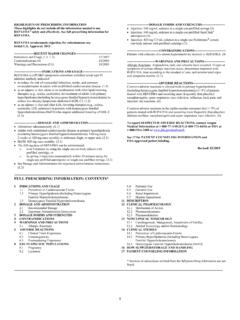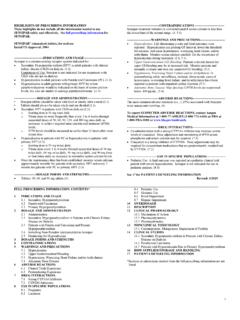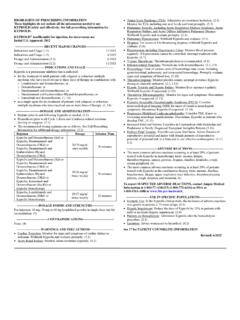Transcription of HIGHLIGHTS OF PRESCRIBING INFORMATION - Amgen
1 Page 1 HIGHLIGHTS OF PRESCRIBING INFORMATIONT hese HIGHLIGHTS do not include all the INFORMATION needed to use XGEVA safely and full PRESCRIBING INFORMATION for (denosumab) injection, for subcutaneous useInitial Approval: 2010------------------------------RECENT MAJOR CHANGES------------------------Warnings and Precautions, Hypocalcemia ( ) 02/2020---------------------------INDICA TIONS AND USAGE----------------------------Xgeva is a RANK ligand (RANKL) inhibitor indicated for: Prevention of skeletal-related events in patients with multiple myeloma and in patients with bone metastases from solid tumors. ( ) Treatment of adults and skeletally mature adolescents with giant cell tumor of bone that is unresectable or where surgical resection is likely to result in severe morbidity.
2 ( , ) Treatment of hypercalcemia of malignancy refractory to bisphosphonate therapy. ( )-----------------------DOSAGE AND ADMINISTRATION----------------------- Xgeva is intended for subcutaneous route only and should not be administered intravenously, intramuscularly, or intradermally. ( ) Multiple Myeloma and Bone Metastasis from Solid Tumors:Administer 120mg every 4weeks as a subcutaneous injection in the upper arm, upper thigh, or abdomen. ( ) Giant Cell Tumor of Bone: Administer 120mg every 4weeks with additional 120mg doses on Days8 and 15 of the first month of subcutaneously in the upper arm, upper thigh, or abdomen.( ) Administer calcium and vitamin D as necessary to treat or prevent hypocalcemia.
3 ( , ) Hypercalcemia of Malignancy:Administer 120mg every 4weeks with additional 120mg doses on Days8 and 15 of thefirst month of subcutaneously in the upper arm, upper thigh, or abdomen.( )----------------------DOSAGE FORMS AND STRENGTHS--------------------- Injection:120 (70mg/mL) solution in a single-dose vial (3)--------------------------CONTRAINDIC ATIONS---------------------------------- Hypocalcemia ( ) Known clinically significant hypersensitivity to Xgeva ( )-------------------------WARNINGS AND PRECAUTIONS---------------------- Same Active Ingredient: Patients receiving Xgeva should not take Prolia . ( ) Hypersensitivity reactions including anaphylaxis may permanently if a clinically significant reaction occurs.
4 ( ) Hypocalcemia: Xgeva can cause severe symptomatic hypocalcemia, and fatalcases have been hypocalcemia prior to initiating calcium levels during therapy, especially in the first weeks of initiating therapy, and adequately supplement all patients with calcium and vitamin D. ( ) Osteonecrosis ofthe jaw (ONJ) has been reported in patients receiving an oral examination prior to starting for invasive dental procedures during treatment with Xgeva. ( ) Atypical femoral fracture: Evaluate patients with thigh or groin pain to rule out a femoral fracture. ( ) Hypercalcemia Following Treatment Discontinuation in Patients with Giant Cell Tumor of Bone and in Patients with Growing Skeletons:Monitor patients for signs and symptoms of hypercalcemia,andmanage as clinically appropriate.
5 ( , ) Multiple Vertebral Fractures (MVF) Following Treatment Discontinuation:When Xgeva treatment is discontinued, evaluate the individual patient s risk for vertebral fractures. ( ) Embryo-Fetal Toxicity: Can causefetal females of reproductive potential of potential risk to the fetus and to use effective contraception. ( , , )--------------------------------ADVERSE REACTIONS----------------------------- Bone Metastasis from Solid Tumors:Mostcommon adverse reactions ( 25%) were fatigue/asthenia, hypophosphatemia, and nausea. ( ) Multiple Myeloma:Most common adverse reactions ( 10%) were diarrhea, nausea, anemia, back pain, thrombocytopenia, peripheral edema, hypocalcemia,upper respiratory tract infection, rash, and headache.
6 ( ) Giant Cell Tumor of Bone:Most common adverse reactions ( 10%) were arthralgia, headache, nausea, back pain, fatigue, and pain in extremity. ( ) Hypercalcemia of Malignancy:Most common adverse reactions(>20%) were nausea, dyspnea, decreased appetite, headache, peripheral edema, vomiting, anemia, constipation, and diarrhea. ( )To report SUSPECTED ADVERSE REACTIONS, contact Amgen Inc. at 1-800-77- Amgen (1-800-772-6436) or FDA at 1-800-FDA-1088 or IN SPECIFIC POPULATIONS---------------------- Pediatric patients:Recommended only for treatment of skeletally mature adolescents with giant cell tumor of bone. ( ) Renal impairment:Patients with creatinine clearance less than 30mL/min or receiving dialysis are at risk for supplement with calcium and vitamin D.
7 ( )See 17 for PATIENT COUNSELING INFORMATIONR evised: 06/2020 Page 2 FULL PRESCRIBING INFORMATION : CONTENTS*1 INDICATIONS AND Myeloma and Bone Metastasis from Solid Cell Tumor of Bone of Malignancy2 DOSAGE AND Administration Myeloma and Bone Metastasis from Solid Cell Tumor of of and Administration3 DOSAGE FORMS AND AND PRECAUTIONS Products with Same Active of the Jaw (ONJ) Subtrochanteric and diaphyseal Femoral Following Treatment Discontinuationin Patients with Giant Cell Tumor of Bone andin Patients with Growing Vertebral Fractures (MVF) Following Treatment Toxicity6 ADVERSE Trials IN SPECIFIC and Males of Reproductive Impairment10 OVERDOSAGE11 DESCRIPTION12 CLINICAL of , Mutagenesis.
8 Impairment of Toxicology and/or Pharmacology14 CLINICAL Metastasis from Solid Cell Tumor of of Malignancy16 HOW SUPPLIED/STORAGE AND HANDLING17 PATIENT COUNSELING INFORMATION *Sections or subsections omitted from the full PRESCRIBING INFORMATION are not listedPage 3 FULL PRESCRIBING INFORMATION1 INDICATIONS AND Myeloma and Bone Metastasis from Solid TumorsXgeva is indicated for the prevention of skeletal-related events in patients with multiple myeloma and in patients with bone metastases from solid Cell Tumor of BoneXgeva is indicated for the treatment of adults and skeletally mature adolescents with giant cell tumor of bone thatis unresectable or where surgical resection is likely to result in severe morbidity[see Clinical Trials ( )].
9 Of MalignancyXgeva is indicated for the treatment of hypercalcemia of malignancy refractory to bisphosphonate AND Administration InstructionsXgeva is intended for subcutaneous route only and should not be administered intravenously, intramuscularly, or Myeloma and Bone Metastasis from Solid TumorsTherecommended dose of Xgeva is 120mg administered as a subcutaneous injection every 4weeks in the upper arm, upper thigh, or calcium and vitamin D as necessary to treat or prevent hypocalcemia [see Warnings and Precautions ( )].Page Cell Tumor of BoneThe recommended dose of Xgeva is 120mg administered every 4weeks with additional 120mg doses on Days8 and 15 of the first month of subcutaneously in the upper arm, upper thigh, or calciumand vitamin D as necessary to treat or prevent hypocalcemia [see Warnings and Precautions ( )].
10 Of MalignancyThe recommended dose of Xgeva is 120mg administered every 4weeks with additional 120mg doses on Days8 and 15 of the firstmonth of subcutaneously in the upper arm, upper thigh, or and AdministrationVisually inspect Xgeva for particulate matter and discoloration prior to is a clear, colorless to pale yellow solution that may contain trace amounts of translucent to white proteinaceous not use if the solution is discolored or cloudy or if the solution contains many particles or foreign particulate to administration, Xgeva may be removed from the refrigerator and brought to room temperature (up to 25 C/77 F) by standing in the original generally takes 15 to not warm Xgeva in any other way [see How Supplied/Storage and Handling (16)].












